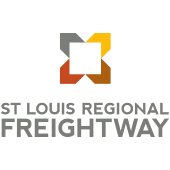St. Louis Regional Freightway’s sole mission is to plan, market and grow the bi-state region as a national freight hub with competitive advantages, unlike no other region.
In 2015, UNCOMN (formerly Aegis Strategies) wrote the strategic plan that helped bring Missouri and Illinois together to create this public-private partnership, and today, Freightway plays a vital role in advancing the region’s freight and distribution enterprises.
St. Louis’ Merchants Bridge is the first bridge south of a lock and dam along the Mississippi River, which makes the city a key hub of transportation between the east and west. A 2012 study revealed that St. Louis’ freight system was being underutilized — largely due to unreliable service and prohibitive costs — so the East-West Gateway Council of Governments (EWGCOG) — the regional Metropolitan Planning Organization — decided to take action.
The EWGCOG asked UNCOMN to lead the creation of a comprehensive strategy and an organizational governance approach to enhance the attractiveness and capabilities of the regional freight system. The strategy resulted in a series of collaborative planning sessions and the establishment of the St. Louis Regional Freightway in 2014.
The challenge: Benchmark performance of rail freight operations with limited, static data
In May 2017, the Freightway Director, Mary Lamie, asked UNCOMN to identify an approach to begin benchmarking performance of rail operations in the region to support marketing efforts and to also provide evidence for funding infrastructure enhancement projects.
Our approach: Fuse existing rail freight data with economic use cases and initiate actions to visualize rail freight flows; and provide a conceptual design framework to establish an enabling Center of Excellence to enhance data collection and analysis capabilities.
A small team from the UNCOMN Data & Analytic Solutions Division conducted a comprehensive assessment of multiple public and private data sources. The team then developed an approach to fuse historic data by general commodity type, by origin-destination pairs, and in the context of rail transfer operations to visualize freight flows in and out of the region.
We also prepared the design for a proposed Center of Excellence to provide the expertise and technological support needed to provide enduring performance analysis and benchmarking capabilities and to support complex analytic projects in collaboration with other stakeholders in the region. The proposed Freightway Center of Excellence provides not only a training ground for best practices but also a central hub for collaboration and storage of diverse types of data.
We then applied insights from our dataset assessment to an increasingly important economic use case affecting St. Louis and the entire Midwest. We started working with the U.S. Department of Agriculture to qualify and quantify the impact of limited spending on transportation infrastructure and its relationship to the export of soybeans and corn from the heartland to growing consumer needs in Asia. UNCOMN developed an approach to collect and monitor the flow of rail traffic related to agribusiness exports in and out of the region.
The results: Proactive solutions to visualize rail freight flows related to specific economic use cases
St. Louis Freightway now has a credible approach for collecting, extracting, synthesizing, and organizing historical data as input for discrete event simulation models. UNCOMN continues to act as a trusted agent on behalf of the Freightway to build a collaborative community of stakeholders eager to further enable agribusiness interests in the region.
With improved access and organization of needed data, Freightway can offer viable performance-based recommendations to State and Federal transportation planning organizations seeking to improve the economic development of the entire region.
“We still have a long way to go,” Mary Lamie, Freightway’s Executive Director, said. “But the opportunity to grow and expand is there. People want to know why businesses are coming to St. Louis, and we’re trying to tell those stories.”


